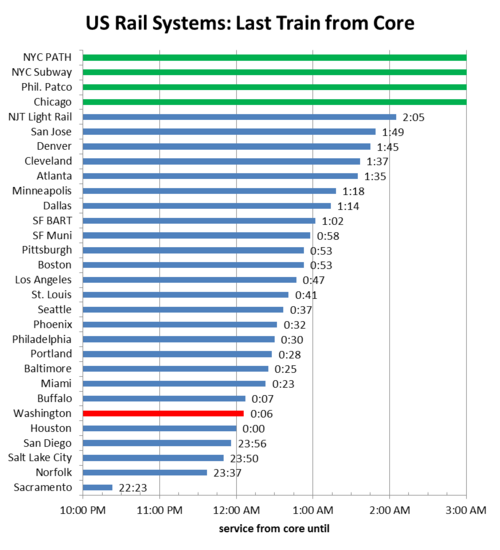Does Metro close too early on weeknights?
Last week, a Nationals game ran late, beyond Metro’s regular weeknight closing time, sparking a debate about who should pay for late service. But there are plenty of riders who could benefit from later Metro service every night, not just evenings with sporting events.
On that Monday, some fans who didn’t know Metro’s schedule or who thought Metro would stay open for the late game showed up at Navy Yard station after the game only the find the last train long gone. It sparked several news articles and much consternation on social media. Much of the ensuing public debate has focused on whether the Nats or the DC government should pay to keep Metro open late.
For a major city, Washington’s transit system seems to close very early. While many people are concerned because it cuts into their nightlife or ability to attend late Nationals games, the heaviest burden falls on service industry workers, whose jobs often keep them out very late.
How does Metro stack up?
I looked at all the heavy rail and light rail systems in the United States, and out of 30 total systems, Metro is the 6th earliest to close.
Because every rail system is different, it’s difficult to compare any one system to another. The measure I used seems to be the most reliable way to compare systems, though it’s not perfect.
To compare each city, I looked up when the last train leaves the central station of each system. For Metro, that’s 12:06 am, when trains leave Metro Center in 4 directions.
5 systems close earlier than Metro by this measure*. Sacramento is the earliest by far, with the last train leaving downtown at 10:23 pm. Norfolk, Salt Lake City, and San Diego all have their last trains through the core before midnight, and Houston’s last departure is at midnight.
Most cities run later. In Atlanta, the last MARTA train leaves the airport at 1:00 am and passes through downtown at 1:35 am, almost 90 minutes after Metro has closed. Even BART, Metro’s suburb-oriented cousin in the San Francisco Bay Area, has its last train departing Embarcadero almost an hour later than Metro, at 1:02 am.
3 American systems operate around the clock. The New York subway, the PATCO Speedline, which goes from Philadelphia into southern New Jersey, and PATH, which connects New York with northern New Jersey.
In Chicago, the Red and Blue lines run 24/7, though the other lines shut down at night. The last train on Chicago’s Yellow Line departs Howard at 11:00 pm. And while Philadephia’s SEPTA closes the Broad Street and Market-Frankford lines, it does run night owl buses along the same routes overnight.
*Note, that this measure looks at the last train leaving the core on any line. In DC, that time is roughly the same for all lines and directions, but in other cities, it can vary a good deal. For example, in Sacramento, the last train from the core is a Blue Line to Watt/I-80 at 10:23. But the last Blue Line train in the other direction (to Meadowview) leaves the core at 9:30.
Applying it to Metro
Metro closes too early. For countless workers in the region, Metro’s early closing time keeps them from jobs or forces them to own a car to get around. For sports fans, Metro’s early closure makes it difficult to take transit to games and means bad press when fans get stranded.
When Nationals games run late, fans need a way to get home. And in special cases, the Nats should be willing to chip in.
But the region as a whole needs to start funding later transit service. Increasing mobility won’t just help baseball fans. It will make the region more accessible to more people.
Metro could extend service so that the last trains departed their terminals after midnight by adding 2 more departures to each line. With 20-minute headways, 2 departures would extend the span of service by 40 minutes, which would be a great start to running service over an even longer span.
That would be enough to bring Metro up to par with its peers in other cities. Of the heavy and light rail systems in the United States, the average last departure from the core is 40.42 minutes after midnight. Adding 40 minutes of span would result in Metro’s last train departing the core at 12:46 am.
Of course it is true that nothing comes for free. WMATA and its member jurisdictions would have to pay for longer hours. But 2 more trains each way on each line wouldn’t add very much cost. At the regional scale it would be affordable, and definitely worth the benefits.
Metro has been using the off periods for track work, but the short night periods don’t give much time to achieve a lot, especially since it takes time to set up and break down a work zone. That’s why Metro has been doing more weekend closures of whole segments of lines, when they can finish more work at one go.


